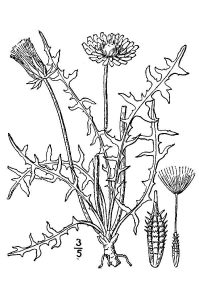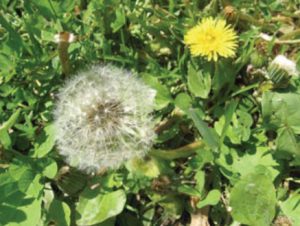Common Dandelion Fact Sheet

The common dandelion is a perennial, herbaceous (i.e. not “woody”) plant that forms rosettes of leaves with yellow flower clusters rising from the center. Dandelions are found throughout all of the US and Canada, as they tolerate a wide range of conditions. Despite the efforts of many to rid their lawns of them today, in the past the dandelion was held in much higher regard and recognized for its medicinal, aesthetic, and nutritive benefits. Named for their “lion-toothed” leaves (dent de lion in French means ‘lion’s tooth’), a salad of dandelion leaves is packed with valuable vitamins and minerals.
Leaves and Flowers: Dandelions grow very close to the ground, with the rosettes of leaves growing directly from the top of the root. Dandelion flower heads, 1 to 2 inches in diameter, are composed of hundreds of individual ray-shaped flowers clustered together. Flowers grow on hollow stalks that can range from 2 to 24 inches tall. Fruit: Flowers develop into seed heads. Each seed is attached to a characteristic fuzzy structure called a ‘pappus’ that allows the seed to be carried by the wind.

Tips on Observing: It is helpful to leave a stake or other marker next to the dandelion plant(s) you are observing over the winter, as you may not otherwise see the first leaves coming out among the blades of grass in the lawn. The dandelion will produce a new rosette of foliage from the same roots in the same spot. New foliage grows up over the old foliage. The new rosette looks like tips of leaves with a flower bud in the middle. Leaves will elongate and the flower will start to open — that first flower is often very close to ground. However, flower stalks can reach up to two feet high.
Sources and Additional Information:

USDA, NRCS. 2012. The PLANTS Database (http://plants.usda.gov, 20 May 2012).
National Plant Data Team, Greensboro, NC 27401-4901 USA.
USA Phenology Network — Observing Plants and Animals, http://www.usanpn.org/Taraxacum_officinale
Ten Things You Might Not Know About Dandelions, by Anita Sanchez, https://www.mofga.org/resources/weeds/ten-things-you-might-not-know-about-dandelions/
Native Plant Database, Lady Bird Johnson Wildflower Center, University of Texas at Austin, http://www.wildflower.org/plants/result.php?id_plant=TAOF
